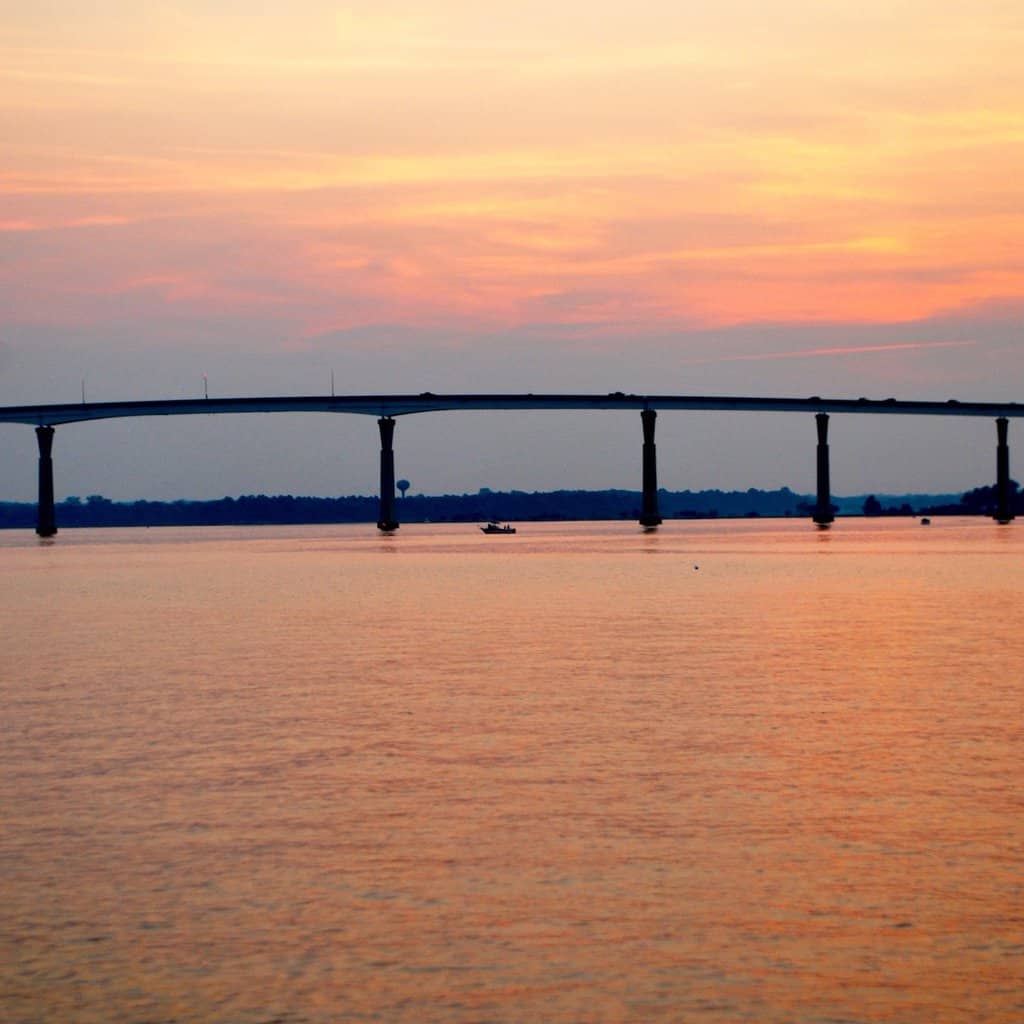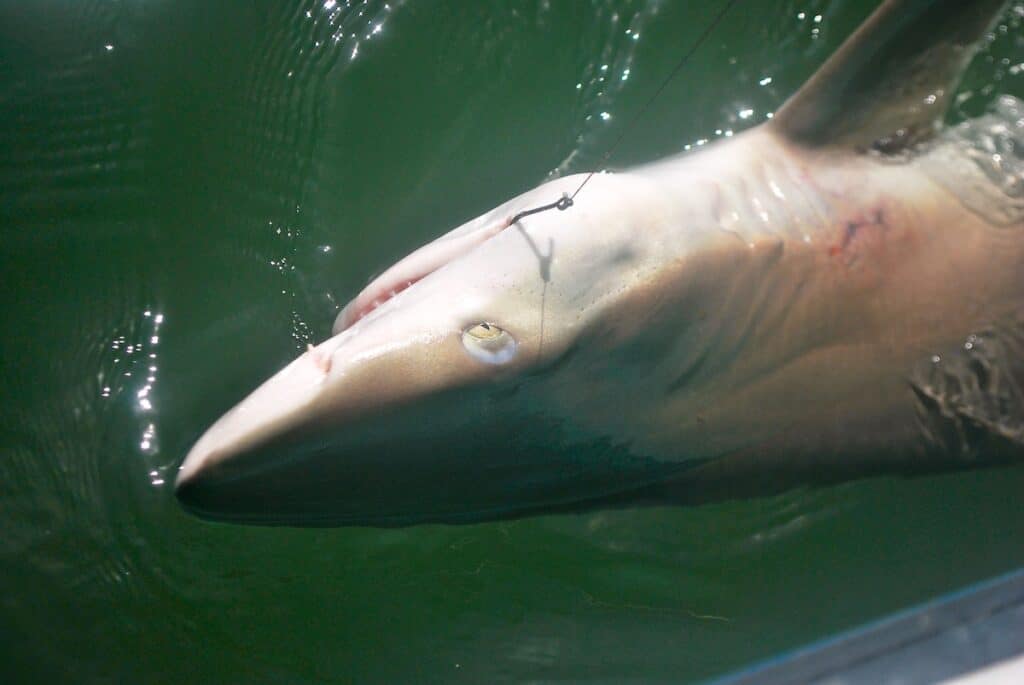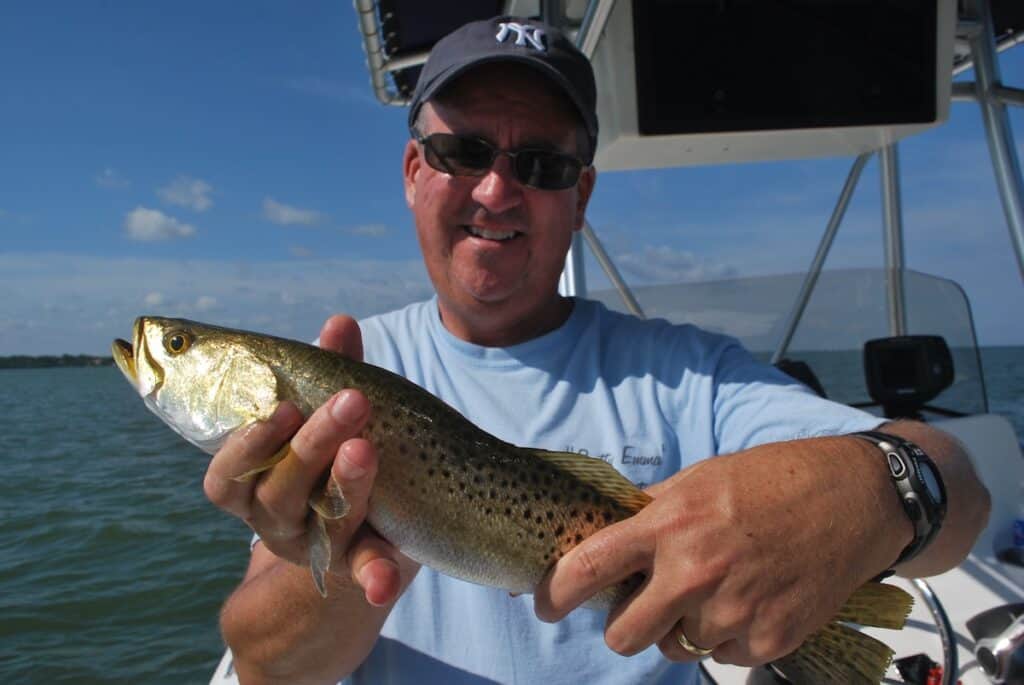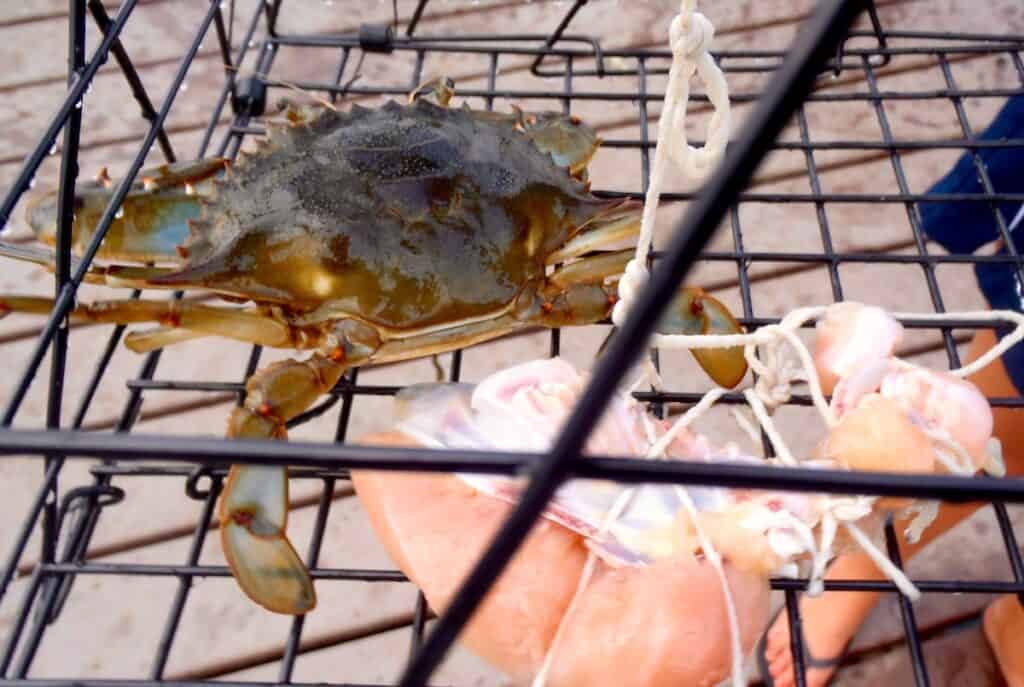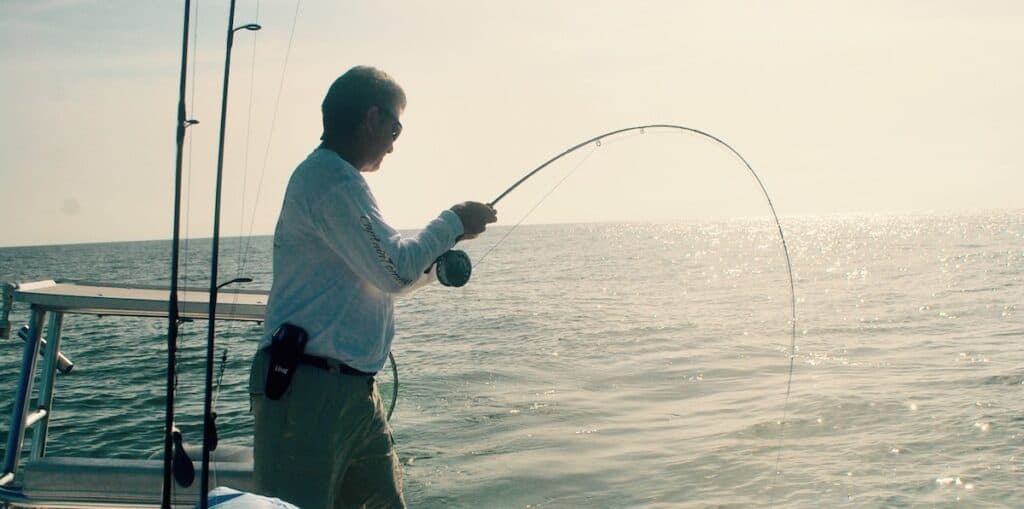There’s no doubt about it: The Chesapeake Bay is one of the richest, most diverse saltwater environments on the East Coast.
And a great place to go fishing.
From striped bass and cobia to sea trout and redfish, this gigantic bay and the tidal rivers that flow into it comprise a virtual angler’s paradise. Consider that you can lazily catch crabs from a dock, catch everything from perch to stripers from beaches and piers or a kayak, or fish the entire bay from a boat.
The Chesapeake is a truly unique and beautiful resource accessible to almost every type of angler.
Major Chesapeake Bay Game Fish
Follow this guide to find your fish.
Chesapeake Bay Striper Fishing
There is perhaps no species more beloved or targeted in the Chesapeake than the striped bass, which some locals call rockfish.
Stripers use the bay and the rivers, including the James, Potomac and Susquehanna that pour into it as their primary spring spawning grounds. That means, if you’re careful to heed regulations that protect the stocks, you can have opportunities at some of the biggest rockfish you’ll see inshore anywhere all year.
An angler favorite has always been the massive Chesapeake Bay Bridge and Tunnel, which stretches 17.6 miles across the mouth of the bay. The numerous pilings and the rocks around them provide ample structure for stripers to duck out of the current and ambush baitfish like Atlantic menhaden (a.k.a. bunker).
Throwing topwater poppers like Zara Spooks, where you can see bunker breaking on the surface, is a great tactic in the spring and fall.
Drifting a live eel around those bridge pilings or similar structures is another fantastic way to catch stripers.
Once summer months warm the bay, the younger stripers that stay in the ball year-round will move into deeper water.
Trolling baits like bunker spoons or hardbaits like Sebile Magic Swimmers can be a great way to cover a lot of the bay for those resident rockfish.
We’ll give you a high-level overview here. For all the critical details on how, where and when, be sure to check out our detailed guide to Chesapeake Bay striper fishing.
Chesapeake Bay Cobia Fishing
These potentially gigantic, structure-loving fish are a favorite Southern species and can offer anglers with enormous fun in the Chesapeake.
Cobia routinely top 40 pounds and might tips the scales much further. There’s a tale of a 112-pound cobia caught in the Chesapeake decades ago.
Cobia typically arrive in the bay between the middle and the end of May, as water temperatures warm to their more tropical preference.
Cobia are not terribly active fish, so search for them in protected areas on the calm side of underwater hills or humps or near steep drops.
For many anglers, anchoring near promising structure and starting a chum slick is their number-one cobia option.
Cobia also are not fussy eaters. Baits of spot, croaker, bunker or eels can all entice these fish.
Cobia are very dark colored and easier to spot than other sport fish. They absolutely love structure, so slow down near buoys, bridge pilings, or floating weeds and check near or beneath them for these large, lazily swimming fish.
If you encounter individual cobia, throwing an eel or chunk of menhaden on a circle hook can be a great bet.
Fishing for cobia is almost like hunting, because your best odds of success will be finding them first, most likely around structure. Then you’ll fish to individuals or small schools of cobia with fresh bait or jigs.
Note that, in the bay, the season runs from June 15 to September 15 to keep a single 40-plus-inch fish legally. Be sure to always check regulations yourself before fishing.
Flounder Fishing in the Chesapeake Bay
As far as eating fish go, it’s tough to top the summer flounder in the Atlantic. These flatfish, also commonly known as fluke, are absolutely delicious.
The flounder fishery is open year-round, and you can keep four fish as long as they’re 16 inches or better.
There are a few keys to flounder-finding that will make dinner easier to procure.
First, remember that these are ambush predators, so they’ll likely be holding flat on the downcurrent sides of humps, hills or other bottom structure.
Second, flounder feed most actively at slack tide.
So, using a squid-strip-tipped bucktail near structure, right at slack tide, can be an enormously promising proposition for flounder fishing in the Chesapeake Bay.
Flounder may appear docile, but don’t be fooled: They are predators that will strike a jig, bucktail or any type of bottom lure that looks like forage fish. The key to flounder success is finding their likely holding spots first.
Chesapeake Bay Croaker Fishing
Croaker are a popular member of the drum family that gets its name from the grunting sound you can often hear from them when you bring them over the side of the boat.
You can target Atlantic croaker (hardhead) year-round and keep up to 25 in a day, making them a popular food fish in the mid-Atlantic, but they aren’t going to be giants like cobia.
You can keep any croaker over 9 inches; any pushing over 3 pounds is a Chesapeake giant. The record is about twice that.
Your best bet to catch this fish is using a tandem-hook bottom rig with a pyramid sinker and squid strips for bait.
Croaker are another structure-oriented fish that often hold near bridge pilings, wrecks or reefs. The summer months of June, July and August will offer your best shots.
Chesapeake Bay Shark Fishing
There are few moments on the water that can compare with fighting and landing a shark on light tackle. Being so close to such an efficient predator with so few natural enemies and so little fear is incredibly memorable.
In the Chesapeake, you can target and catch oceanic whitetip sharks, blacktip sharks, bull sharks, hammerheads, lemon, nurse, and spinner sharks, as well porbeagles, bonnetheads and thresher sharks.
Many species have a minimum fork length and a closed season, but you can check out the exact specifics per species here.
Drawing these apex predators in will be much more efficient than seeking them out. To get sharks coming to you, create a chum slick.
You can do this in various ways, but the most effective one involves live or freshly dead menhaden. These oily baitfish are a crucial staple in the Chesapeake food chain.
Step one is to procure a few dozen, either by snagging them with a weighted snag hook or throwing a cast net over a pod on the surface.
Step two is cutting them up. You can slice the bunker with a knife or grind them up to ensure they release the most scent.
Next, drilling ½-inch holes in a 5-gallon bucket will suffice for a chum dispenser, although there are certainly more sophisticated devices if you want to spend the money.
Make sure you are up-current of a promising flat before setting up your chum slick. This works best on a moving tide.
Now it’s time to rig a rod with either a chunk of bunker or a live one. Use a blown-up balloon for a floatation device (think: Giant bobber). The balloon will be more visible from a distance.
The most critical aspect is setting up your chum slick near a flat with a strong current, tidal creek, or a steep drop-off nearby.
Sharking can be a game of patience.
Check regulations to see if a special permit is required to target or keep a specific species. Keep in mind that there are strict regulations, so make sure you can identify different shark species and know how to handle them before you go sharking.
And definitely do not put your hands around the mouth of any shark you land.
Spade Fishing Chesapeake Bay
Spadefish, or simply spade, are a zebra-striped fish in the mid-Atlantic commonly found around structure like sand bars or jetties.
The most popular means of targeting these guys is anchoring up near a jetty, deploying a canister or net bag of clam chum, and waiting for them to come to you.
Light-tackle gear with clam-baited hooks thrown into the chum slick will be effective most times.
Typically, these fish will be in the 1- to 3-pound range, but 4- and 5-pound spadefish are caught every year. The Maryland state record is a 10-pound fish.
Spade are typically found inshore in the warm-water months of April through October. They move offshore for the winter months.
Perch Fishing Chesapeake Bay
For Chesapeake white perch, the first key will be finding the hard-bottom shoals that these fish like to hold on in the bay.
Summer will be your best season for targeting these fish in the Chesapeake.
While you can thread shrimp tails onto small bucktail jigs and have success, a Sabiki rig, like those typically deployed for mackerel, will yield just as much success nine times out of ten.
Small paddle tail swimbaits thrown at creek mouths, nearby points and jetties can be another effective means of getting a day’s limit of perch, especially in the fall.
Chesapeake Red Drum Fishing (Redfish)
Redfish or Red Drum are a mid-Atlantic favorite, and for good reason.
These voracious predators, also known here as channel bass, will eat anything from smaller baitfish to crabs to shrimp.
It’s fairly common to see redfish so shallow on a tidal flat that the water is not even covering their tails. When spooked, tailing reds create a massive wave of simultaneous movement on a flat that can be breathtaking.
Redfish put up a bull-ish fight with long runs when hooked.
Once you land them, it becomes even more fun. Every fish has a unique tail pattern with a varying number of spots, or false eyes. Some redfish have the classic single false eye, while others have dozens of spots up and down their flanks.
When they consume more shellfish, redfish have a blue tint to their tails and fins ranging from barely perceptible to almost neon. They’re a thick, muscled fish capable of amazing fights.
A warmwater fish, you’ll have your best shots at Chesapeake redfish in the summer months. The peak is often late summer into early fall when water temperatures peak.
They’ll haunt creek beds and shallow flats near tidal creeks on swiftly moving tides in search of crabs, shrimp and crustaceans.
There are a few local favorite baits for redfish, but a shrimp-tipped bucktail is tough to top.
They also can be taken on topwater with walk-the-dog-style baits.
The shoals at the mouth of the Chesapeake are most likely to hold these fish, which like to push their prey into tight quarters.
If you can find bluefish blitzing baitfish on top, there’s a good chance that red drum will be under them, gathering up the scraps that fall from the blitz. Think: blue on top, red on the bottom. Dropping birds are usually a good indication of frenzied bluefish.
Binoculars can be handy to keep on board so you can double-check what looks like a safe distance when making long casts.
Spoons like the Luhr-Jensen Pet Spoon trolled between three and five miles per hour near promising structure (drop-offs next to flats) can be productive as well.
Chesapeake Bay Black Drum Fishing
Black drum are even larger than their redfish cousins, capable of pushing 100 pounds.
Black drum, however, are more prone to bottom feeding than are red drum, and fresh bait is almost always used to target them. These bottom feeders prefer clams, crabs or oysters as the staples of their diet and are thus trickier to fool with a lure.
These fish have barbels on the bottom of their chin that they use to detect their next meal so it’s almost essential to bait and wait when targeting them.
Drum spawn in the late spring and early summer, after which they move into the Chesapeake to feed.
Because these are bottom-feeders, down-imaging sonar will be crucial in locating them. Even smaller “puppy drum” are typically 8 to 15 pounds, so marking the larger adults with a good fishfinder is very possible.
The use of at least medium-heavy, if not heavy, rods and braided line of at least 40-pound test is highly recommended. A fluorocarbon leader is ideal to tempt these wary fish when using bait.
You can target drum year-round but they must be 16 inches to keep. The limit is just one per angler, and a boat can keep a maximum of six.
Late April through mid-June will give you your best chance at catching the fish as they typically move farther into the bay post-spawn to feed.
Chesapeake Bluefish
Bluefish are voracious predators that can provide a lot of fun for Chesapeake anglers, typically in April, May, June and October and November.
These fish spawn on offshore grounds, migrate inshore in the spring, and then follow bait like sand eels, Atlantic menhaden and mackerel northward up the coastline.
When Northeast waters cool, they migrate back down the coast, returning to the Chesapeake region in the fall.
Bluefish typically travel in large schools that you’ll often find wherever there are large schools of bait.
They’ll push these smaller fish inshore in cooler water, using near-shore structure like sand bars and drop-offs to their advantage, but they’ll typically offshore in the summer and often farther south in the winter.
Baits that mimic a baitfish between two and five inches and are hardy enough to withstand a toothy trashing are your best bet. Deadly Dicks, Diamond Jigs, pencil poppers or little neck poppers are all fantastic baits when bluefish are around.
As counterintuitive as it may sound, trying to keep your bait away from schooling, feeding bluefish will actually have them feed more ravenously. I’ve seen fish spook or turn away from a lure when it’s stopped or sitting idly, but they’ll give chase to a bait that appears to be fleeing rapidly.
Topwater lures that mimic a fleeing menhaden can be particularly effective (and fun) when blues are blitzing.
Handle these fish with extreme care as their teeth are razor sharp and actually have an anticoagulant that will keep you bleeding if you get nicked.
It’s worth noting that blitzing bluefish will often be mixed in with other species of predatory fish, including striped bass and Spanish mackerel.
Chesapeake Bay Speckled Trout/Gray Trout
Speckled sea trout and gray trout, in a closely related family of very similar species often called spotted seatrout or weakfish, are a beautiful and delicious fish that are present to varying degrees up and down the Atlantic coast from Florida to Massachusetts.
Warming water temperatures in the spring will bring these fish into the bay. They prefer water temperature in the 65-75 degree range, so keep an eye on bay temperature in April and May when looking to target them specifically.
Seat trout move offshore in the fall when temperatures drop.
A bucktail jig with either an artificial trailer (like Gulp! or your bucktail trailer of choice) or the body of a shrimp threaded onto the hook can be effective means to target them.
Weakfish can range in size, but anything larger than 25 inches is a serious trophy. A 24-inch plus fish earns a citation in Virginia waters.
Blue Crab Fishing Chesapeake Bay
Crabbing in the Chesapeake is a time-honored and fun family tradition. It can be as simple or as complicated as you want it to be.
Traditionally, you simply get some raw chicken, put it in a crab trap, lower it near a dock or structure, and wait. It’s as simple as that.
Anglers can keep two dozen male hard Atlantic blue crabs and one dozen “peelers,” which are just blueclaw crabs that have outgrown and shed their shell. The crabs typically molt, or shed their shell, beginning in late April when the water warms up and continuing through the fall.
Typical crab pots have folding sides that close in on the blue crabs when pulled up.
For more challenge, you can use chicken necks or pieces of fileted fish remnants tied to a string. When you see or feel crabs picking at your bait, slowly pull up and have a dip net handy to grab the crab(s)!
Hard crabs need to have a shell width (they sell crab-measuring gauges) of at least five inches, while soft crabs need a width of at least 3.5 inches.
You can easily buy simple crab-measuring gauges but double-check that you comply with crabbing regulations, including the legal number of traps and lines.
Lobster Fishing Chesapeake Bay
In the state of Virginia, you do need a commercial license to target lobster, which you can learn more about here.
In Maryland, any person can keep up to 100 lobsters in a 24-hour period, provided they meet the size specifications, which requires that they’re between 3 3/8ths and 5 ¼ inches in “carapace length.” That is the length from right behind the eye socket to where the body part of the shell meets the tail part of the shell.
Special lobster-measuring devices are sold and highly recommended.
Where to Fish on the Chesapeake
For the purpose of discussion, the bay is often divided into the Upper, Middle and Lower Chesapeake. Here’s what that means for us as anglers.
Upper Bay
The Upper Chesapeake is the farthest region from the mouth of the bay, and so, has the lowest salinity.
Areas here transition toward species traditionally found in freshwater, like largemouth bass. In fact, the Upper Chesapeake is a largemouth factory and is growing in popularity among East Coast anglers.
Typically, a salinity of 0.5 parts per thousand (ppt) or less of dissolved salts to water is found in the Upper Bay. The Susquehanna and Potomac rivers that flow into the bay tend to give its western portion a lower salinity than the eastern bay.
The Middle Bay
Water with a salinity of greater than .05 and less than 25 ppt is found in the Middle Bay.
The Lower Chesapeake
The lower part of the bay is closest to the Atlantic and has the highest degree of salinity and the highest abundance of saltwater species.
The lower Chesapeake is where your greatest concentration of red drum, black drum and sea trout will be.
Chesapeake Bay Fishing Spots
The Chesapeake Bay Bridge and Tunnel (CBBT)
As mentioned for striper fishing, the massive Chesapeake Bay Bridge and Tunnel has always been a game fish magnet.
Predatory fish ambush Atlantic menhaden passing the bridge, especially in the spring.
Anglers using topwater plugs, jigs, or natural eels or bunker near the pilings is a proven tactic.
The pilings at the southwestern end and northeastern end, respectively, have traditionally been the most productive.
To boost your odds even further, fish along the southwestern end of the bridge on a rising (incoming) tide, and from the northeastern end on a dropping (outgoing) tide.
Chesapeake Bay Fishing Piers
Sea Gull Fishing Pier
This popular fishing spot juts off the Chesapeake Bay Bridge and Tunnel, a few miles off the southern end.
Although the pier was temporarily closed for reconstruction at last check. That project has been delayed before and is currently slated to re-open in 2024. Be sure to check its status before counting on fishing here.
The lighted pier attracts baitfish, stripers, and bluefish in the spring and fall at night.
Bait anglers can have luck throughout the day from the pier, while anglers throwing jigs and topwater plugs will have the most success at first and last light.
Ocean View Fishing Pier
Between the Chesapeake Bay Bridge and Tunnel and the Hampton Roads Bridge, you’ve got the Ocean View Fishing Pier extending right into the Chesapeake in Norfolk.
At nearly 1,700 feet long and 16 feet wide, the pier provides plenty of angler access.
The well-appointed pier has a tackle shop and restaurant and is open 24 hours every day, weather permitting. A fee covers access and your fishing license.
Hey, having a fried flounder dinner at the restaurant on the pier is a pretty good backup plan in case the fish aren’t biting.
Access: Ocean View Fishing Pier parking is at the intersection of W. Ocean View Avenue and 4th View Street in Norfolk.
Buckroe Beach/James T. Wilson Fishing Pier
Fish entering the Chesapeake will run into Buckroe Beach in Virginia soon after they swim under the Bay Bridge and Tunnel, so it’s an ideal spot to fish, especially in the spring.
Sea trout, redfish and cobia are regularly caught from the pier throughout the year.
The 16-foot-wide pier is handicapped accessible and has just about everything you’d need, from a restaurant to a bait shop, right on site.
Anglers who’d rather fish from the sand can work the nearby Buckroe Beach.
Access: Parking for the James T. Wilson Fishing Pier is at 330 S. Resort Boulevard, near the intersection of Seaboard Avenue and S. Resort Boulevard.
East Ocean View Pier
The East Ocean View Pier in Norfolk offers anglers a different environment as it extends into Little Creek, offering more inshore fishing than the previously mentioned piers.
The 134-foot pier is popular among anglers targeting sea trout, bluefish, or, because it’s in a protected bay, anglers with crab traps looking to get a bucket of blue crabs for the table.
Croaker and spot are also common catches from this pier, which is a popular destination because there is no fee for entry.
There are also headboats that leave from the pier if you’re not having luck from land.
Access: The pier is behind the East Ocean View Community and Senior Center on 20th Bay Street.
Elizabeth River Boat Landing and Fishing Pier
This is a great fishing location in a city park has it all for the solo angler or family outing.
There’s a paved ramp if you’re launching a boat or kayak, a snack shack to grab a bite with the kids, a playground in case the kids get bored fishing, and the pier is a popular spot for crabbing as well.
A paved walking path is accessible for people with disabilities.
There’s even a certified scale in case you catch a potential record and fish cleaning stations.
Access: Elizabeth River Park is off Poindexter Street at the eastern base of the South Norfolk Jordan Bridge. Take the Truxton Steet exit to Elizabeth River Way.
Saxis Fishing Pier
Right on the border of Maryland and Virginia, this relatively small (100 feet) public fishing pier at the Saxis Wildlife Management Area is popular for crabbing as well.
Anglers who want to relax with family can soak a bait or cast a lure from the pier. More ambitious anglers can launch a canoe or kayak into the Saxis Wildlife Management Area, a marshland that has largely been spared from human development.
While the area also is popular for hunting, anglers will find black drum, redfish, sea trout, croaker and flounder in this tidal estuary.
Access: The intersection of Startling Creek Road and Saxis Road in Saxis will put you right at the Saxis Fishing Pier.
Note: You’ll find some additional piers with good rockfish angling mentioned in our Complete Guide to Chesapeake Bay Striper Fishing.
Chesapeake Bay Fly Fishing
The Chesapeake can be an incredible place to wave the long rod, and thousands of anglers see some of the best fly fishing on the East Coast every year here.
Stripers on the Fly
In the early spring and late fall, Clousers and other streamers imitating sand eels can be deadly. While a seven- or eight-weight rod might suffice in tidal creeks and back bays, a nine-weight is best for true surf scenarios to cast a fly into potential headwinds.
Redfish on the Fly
East Coast saltwater anglers have some astonishing species to choose from when fly fishing, but redfish have to be in any conversation about the most thrilling fish to target in bays.
These fish can swim so shallow and explode so violently on a fly that it defies description.
Shrimp-, crab- and mullet-patterned streamers will be your most effective bet. Seeing, leading, casting to and hooking a redfish in extremely shallow water is one of the most thrilling moments any saltwater fly angler can experience.
Sea Trout on the Fly
Sea trout, or squeteague, are another highly aggressive Chesapeake game fish that can fall for a well-placed streamer. These fish, typically smaller than redfish or stripers, can be targeted with six- and seven-weights.
They often will hit larger Wooly Buggers or Leech patterns readily when feeding.
Chesapeake Bay Fishing Charters
Maryland Charter Fishing
Chesapeake Beach
This area an hour east of Washington, D.C., has long been a popular destination for Mid-Atlantic anglers. Everything you need for a successful day on the water is right here.
There’s a fleet of charter boats here to choose from, ranging from a party boat that can accommodate dozens of anglers, to a host of smaller private charter boats.
You can see a listing of captains that run out of Chesapeake Beach. There’s a resort, boat rentals and various fun cruises for your longer stays.
Turkey Point Island
Turkey Point Island on the Chesapeake, about an hour south of Baltimore, has a harbor with a number of charter boats, ranging from private charters to larger headboats.
Take Turkey Point Road in Mayo, Maryland to the end to find the charter boats.
Fairwinds Marina
Fairwinds Marina sits where Deep Creek dumps into the Chesapeake in Annapolis, Maryland, and is another harbor where a good number of charter captains keep their boats slipped.
Follow Fairwinds Drive in Annapolis to the end of the road to reach the marina.
More Maryland Charter Fishing
Here’s a directory of Maryland charter fishing boat operators.
Virginia Charter Fishing
For anglers looking to hop a Chesapeake charter in the commonwealth of Virginia, Virginia Beach has a variety of options, from headboats to private charters.
We couldn’t locate a full directory of charter boat operators who fish the Chesapeake and are based in Virginia ports, but here are a few that look promising.
Rebel Sportfishing: These guys are a deep-sea charter for anglers looking to target larger, offshore species. They’ve won a White Marlin Open, a tremendously popular tournament held every August in Virginia, so they know what they’re doing.
First Landing Charters: These guys offer a wide variety, from inshore, light-tackle, to offshore species, and can accommodate guests looking for whale- or dolphin-watching opportunities as well.
Long Time Comin’: These guys are another outfit that does it all, and they specify shark fishing, so if the idea of tangling with something with teeth has you intrigued, give them a call.
Kayak Fishing Chesapeake Bay
For anglers fishing from a kayak, here are a few popular places to put in.
Elizabeth River Boat Landing
Right beneath the South Norfolk Jordan Bridge of I-464, this is an easy spot for kayak or canoe anglers to launch.
Great Bridge Lock Park
This park on the Elizabeth River in the town of Chesapeake is an especially great location for anyone looking to accommodate anglers with disabilities. There’s also a playground for little anglers.
Hallowing Point Boat Ramp
This ramp, located at the end of Hallowing Lane in Hallowing Point, Maryland, puts you right on the Patuxent River which flows into the Chesapeake.
Maryland Kayak Outfitters
If you’re traveling light, this is the place for you. You can rent everything here, from a kayak (pedal or paddle) to fishing rods, and even hire a guide for a scenic tour.
Romancoke Fishing Pier/Canoe & Kayak Launch
At the end of Romancoke Road in Romancoke, there is a fishing pier where, for a daily fee, you can launch a boat, canoe or kayak.
More Water Access
This is an excellent site that allows you to search geographically for Maryland boating and access sites nearest you on the Chesapeake.

